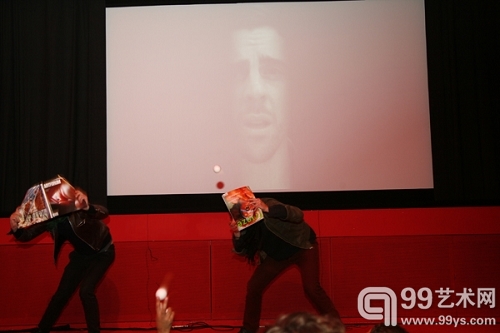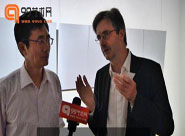

阿瑟瑞曾目睹过三个警察对一个手无寸铁的人嚷道:“站住,搜查!”,然后对他施暴,这也促使了她创作《愤怒的球》这件作品。受到乔治·阿甘本(Giorgio Agamben)的名作《神圣的人[1]:君主权力与赤条条的命》(Homo Sacer: Sovereign Power and Bare Life)(1998)的影响,《愤怒的球》体现的是没有权利的生物性个体,它处在法律体制之外。以色列统治下的巴勒斯坦人正是典型的“神圣的人”,他们被国家控制,但是却得不到法律保护,甚至不被视为国家公民。《愤怒的球》讲述的是在全球化背景下不断加强的国家控制与安全机制,以及艺术可以使我们免于这种控制的幻想之间的复杂关系。这件作品还以一种精神分裂症的方式表现了艺术世界所关注的现实、战争与矛盾冲突等问题。带有政治色彩的艺术总是或多或少地处于监视之下。《愤怒的球》所提出的问题是:无论是作为局内人还是局外人,艺术家应该如何处理政治与现实生活之间的关系?
《愤怒的球》在表演过程中,有无数个球让观众用来掷向表演者。表演者们要尽力用艺术杂志挡住球,来保护自己,并且有时候还可以将球掷回观众,从而造成一场完全安全无伤害的暴乱。观众和表演者之间的这种互动引发了一些问题,譬如关于愤怒的本质、观众与表演者之间的契约限制、本能反应和儿时对于扔球游戏的喜爱。
Extracts from the Essay
Every Alter Ego has a Different Memory
by Stephen Wilson
Extracts from the same name Essay
Published by the Live Art Development Agency, in Ashery’s monograph Dancing with Men, 2009
In adopting the use of alter egos, fictional characters and various biographies, Oreet Ashery constantly reminds us how the very existence of multiple selves is a liberator of difference. Yet Ashery’s individualism triumphs over the varied representations of meaning attached to her characters. Her interactive performances and other works, over the last ten years demonstrate a predilection for characters that are both standardised within community settings as well as being unorthodox. Throughout this period, she has been cultivating a viewer’s perception of the probable function and use of an alter ego as one of the underlying premises of her practice. She rather conspicuously creates a global view of anti-social misfits who are in fact a creative bunch,1and even more majestic is that they somehow represent authentic lives with or without the authoritarian consent of art and life.
…
2.
When encountering Ashery’s Angry Drum, one’s first reaction is to wonder what the drum is angry about. Apart from its exquisite little face drawn by Ashery, the drum, has an outer ring – chequered in red and white paper and glued to a frame – that includes the words “Made in Syria” typed to a scuffed sticker. Drums are the subject or the object of continual battering – no wonder this one is angry. Knowing Ashery’s political concerns, one can safely assume a metaphoric link (and especially after 9/11) to Western perceptions of the Arab world. Moving away from the Syrian reference, it is not possible to discern a specific gender to the drum, neither can it hear anything, as it has no ears, drawn or other wise. This leaves one guessing as to how anger might be represented. What is sure is that anger is readily represented and the viewer is compelled to partake in the burden of the drum’s responsibilities.
The Angry Drum is no more than a prop that sits - for the most part – on a wall in Ashery’s home, and yet occasionally it is used for the purposes of art. I am personally fascinated by its angry and grumpy face. When gazing into its flatly drawn features (done by way of a permanent marker), one becomes engaged with a steadfast but vacuous stare whereby the inanimate nature of the drum (and the silence attached to this exchange) invites a troublesome query into the nature of personal commitment to the project of anger or indeed to any other forms of identification. The anger seems to subside into an abstraction to the point that it is no longer clear what the anger is alluding to. While looking into the penetrating eyes there exists moments where you forget that this is an angry object of contention. In many senses the drum is not angry at all, but pulls the viewer cleverly into the speculation of anger that is ultimately charged with assumptions; assumptions which any viewer will admit to but rarely face. Whether cultural, personal, or political, Ashery’s work is highly engaged with these concerns and how we locate them. At times it appears that its engagement is so consuming, so active, that the balance between what is understood as an art practice is under constant scrutiny. It is not new to occupy diluted yet inclusive forms of socio-political narratives, and register co-existent thematic ties while at the same time exert feelings of resentment. The Angry Drum appears as a beautiful portrait, even if it does centre on a misleading face; a gender-less being; a figure who will not listen; something tells us that it is right to be angry.

